
|
|

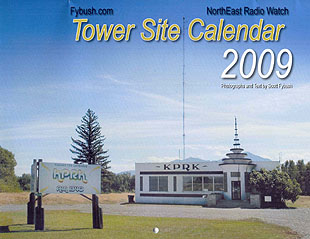 October 24, 2008
October 24, 2008
WFIR, Roanoke, VA
So we're all done with our recap of Big Trip 2007 - and just a few weeks ago, a big pile of boxes of Tower Site Calendar 2009 came back from the printer, all ready for sale and for your office or transmitter shack wall. We hope you'll take a moment to get your order in for the calendar, or better yet, show your support for Site of the Week and NorthEast Radio Watch with a subscription!
This week, we kick off a multiple-installment "Little Trip," recapping our travels as we made our way to Charlotte, North Carolina for last year's NAB Radio Show.
We actually flew into Charlotte, but immediately hopped in the rental car and headed several hours north to do something we should have done on a much earlier trip: get inside the transmitter site of Roanoke, Virginia's WFIR, one of the most unusual directional arrays in America.
WFIR, you see, is located at the Towers Shopping Center - or rather, the Towers Shopping Center is located around WFIR!
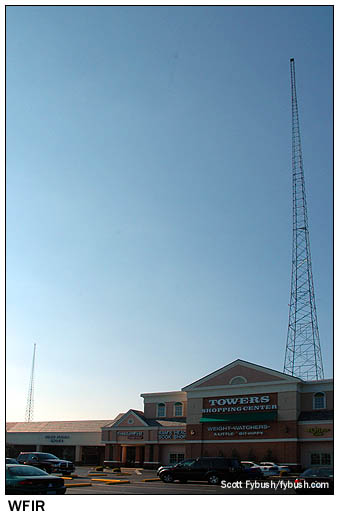
 Here's
how this unusual situation came to be:
Here's
how this unusual situation came to be:
WFIR stands for "First in Roanoke," because that's just what this station is.
As WDBJ, it signed on June 20, 1924 from the offices of the Richardson-Wayland Electrical Corporation in downtown Roanoke.
In 1936, WDBJ built a 312-foot tower and a spacious two-story transmitter building on what was then an open piece of land in the Colonial Heights neighborhood of Roanoke. Around the same time, the station also started building a lavish studio facility on West Kirk Street in the city.
WDBJ-TV (Channel 7) signed on in 1955, occupying studio facilities in the Times-World building next to those of WDBJ radio, which had moved in with its newspaper owners in 1953. In 1961, WDBJ-TV moved out to Colonial Heights, just down the street from the AM transmitter site, but radio stayed put with the newspapers until 1969, when it and the TV station were spun off to separate owners.
The new owners of the radio station were the Vodrey family of Canton, Ohio, who also owned WHBC radio there. They changed the radio station's calls to WFIR, and they moved the studio to the transmitter site.

|
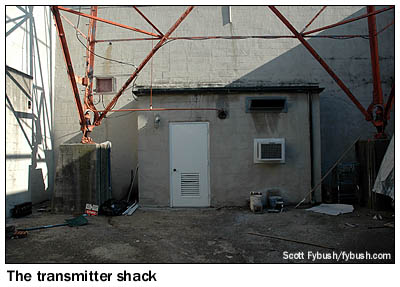
|
By then, though, the transmitter site had changed dramatically. In 1961, the sloping field around the WDBJ transmitter building, by then home to a two-tower array, became the site of the Towers Shopping Center, a two-level strip mall constructed entirely around the original 1936 tower. By the time the studios arrived in 1970, they ended up in a space on the mall's lower level, looking out on the parking lot that in turn led down to tower #2 (and to the funky tower-shaped sign that announces the shopping center to drivers on Brandon Avenue!)
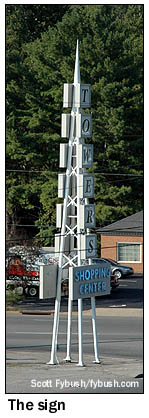
|
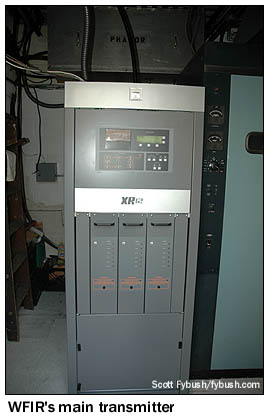
|

|
When we finally made it inside in September 2007, we followed chief engineer Josh Arritt through the small enclosed area on the mall's upper level to an unmarked doorway - and then through another doorway just past that one, leading into the small well in the building where tower #1 rises up into the air.
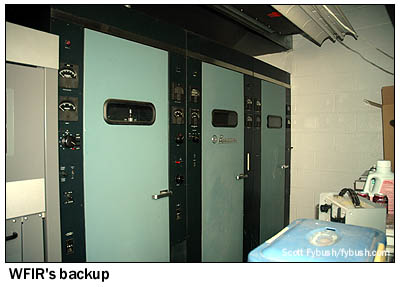
|
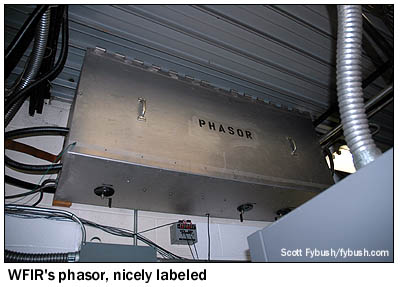
|
The original transmitter building was replaced by a little room accessible only from the tower well, and in there we find WFIR's vintage RCA BTA-5U transmitter and the newer Nautel XR5 that supplanted it. Where's the phasor? Suspended from the ceiling, of course, in that metal box helpfully labeled "PHASOR"!
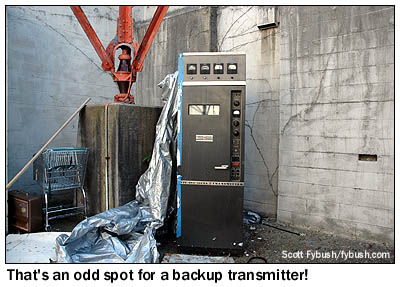
|
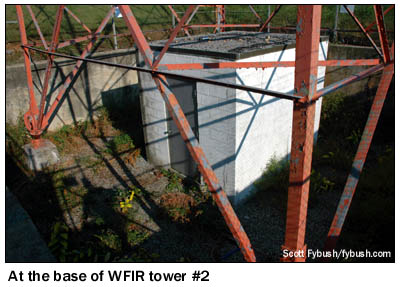
|
Where the Nautel now sits, WDBJ/WFIR used to have an RCA BTA-500MX transmitter; it now sits outside under a tarp, eventually to find new life as a ham rig on 160 meters.
Back outside we go, down to the lower level of the mall, through the parking lot and down the hill to Tower 2, which sits in a little well of its own next to one of the mall entrances, within sight of that wonderful tower-shaped sign. There's not much to see inside the tuning house that sits within the tower base, but there is an interesting story here - the raceway that carries the transmission lines from the inside of the mall out under the parking lot to tower 2 also carries the occasional rodent, we're told!
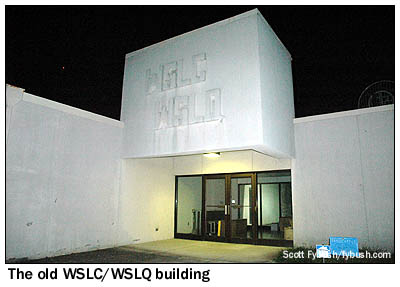
|
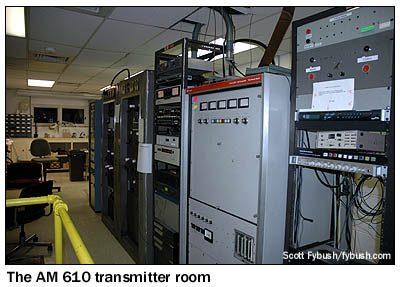
|
As distinctive and as unusual as WFIR's setup here is, its days are numbered. Rent at the shopping center is expensive, and all that RF in a congested area causes interference issues, too. So the station has been granted a CP to move out of town, to the site in neighboring Salem, Virginia that was built for its erstwhile competitor at 610 on the dial. That station began as WSLS, and was later known as WSLC; it's now WVBE. (The old WSLS-WDBJ rivalry lives on over on the TV dial, where WDBJ-TV 7 and WSLS-TV 10 are still fierce competitors!)
This big building is mostly empty these days, thanks to consolidation. The Mel Wheeler group eventually absorbed WFIR and its FM sister at 94.9, the erstwhile WPVR, as well as the 610 signal (which transferred its WSLC calls and country format to 94.9), 610's own sister FM, WSLQ 99.1, and top-40 WXLK 92.3.
Eventually, all of the stations ended up with studios at an expanded building on Electric Avenue at the site of the old WXLK facility, leaving only the shells of the WSLC-WSLQ studios and the 610 transmitter room, with a Nautel main and an old Collins Power Rock as backup. We'd expect this room to get more crowded soon, as WFIR builds out its 10 kW day/4800 watt night facility here, and as WVBE boosts its power to 10 kW days as well.

|
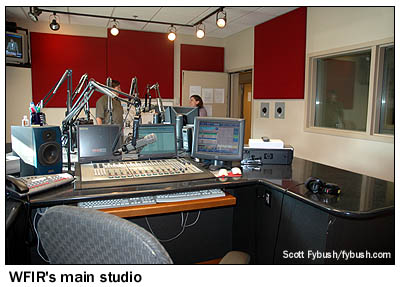
|
As for the Electric Avenue studios, we'd actually been inside once before, during our initial 2003 visit, when we stopped by just as the addition was being completed and just as news director Mike Ward was moving on to new challenges. Fittingly, Mike was with us again in 2007, when he finally got the chance to see the transmitter site he used to broadcast from. (You can see him hiding behind the mic booms in the spacious WFIR studio in the photo above.)
In next week's installment, we'll dig deeper into Roanoke's tangled FM and TV history as we take a ride up Poor Mountain.
- Previous Site of the Week: WHTT/WBBF and WEDG/WWWS, Buffalo
- Next Week: Poor Mountain, Roanoke, VA
- Site of the Week INDEX!
- How can you help support Site of the Week? Click here!
- Submit your suggestions for a future Site of the Week!
